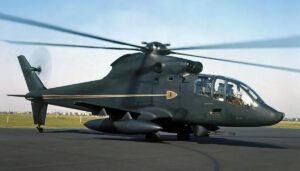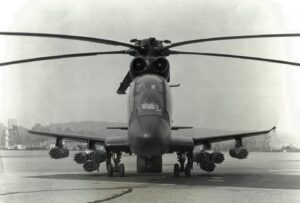The Sikorsky S-67 Blackhawk was a privately-funded, prototype assault helicopter developed in 1970 using funds from Sikorsky Aircraft’s research and development (R&D). As a tandem, two-seat helicopter built around the dynamic drive and rotor systems of the Sikorsky S-61, it was designed for both attack missions and transporting up to eight soldiers into battle.
Here’s What You Need to Remember: The S-67 Blackhawk was not only fast but also delivered a powerful punch. During an assault mission, the helicopter could carry over 7,000 pounds of weapons and ammunition, including a turret-mounted 7.62 machine gun, 20 and 30mm cannons, 40mm grenade launchers, and wing-mounted rockets or TOW missile pods for engaging heavy armor or tanks.

Sikorsky’s H-60 series of Black Hawk helicopters have gained a legendary reputation for their battlefield capabilities. However, nearly a decade before the first UH-60 entered service, Sikorsky had a different type of Blackhawk in mind: the S-67 attack helicopter.
One year before the United States engaged in the Vietnam War, the U.S. Army requested proposals for the Advanced Aerial Fire Support System (AAFSS) program, aiming to be the first program in history to design a helicopter specifically for armed military action. By February 1965, the Army awarded contracts to both Lockheed and Sikorsky for further development of their respective designs, with Sikorsky submitting their S-66, and Lockheed offering their CL-840 Cheyenne. In the end, Lockheed’s proposal won and secured a developmental contract for 10 combat helicopters. However, the program was abruptly canceled in 1969 after Lockheed failed to address several technical issues within the Cheyenne.

Following the failure of the Cheyenne, the Army was left operating their backup plan: the less advanced and therefore less complex and expensive Bell AH-1G Cobra, which would go on to earn fame for the Army and Marine Corps for decades. But back at the Sikorsky offices, the company whose founder invented the first practical helicopter in history went back to work on their designs for an attack helicopter.
An attack helicopter without a defense contract

Fully aware that the United States was quickly recognizing the value of capable military helicopters like the UH-1 Iroquois (better known today as the “Huey”) in Vietnam, Sikorsky began work on another attack helicopter design. This new rotorcraft would incorporate lessons learned from developing the S-66 and from the Cheyenne’s failure. By mid-1969, Sikorsky started initial development on their new high-speed helicopter gunship: the S-67 Blackhawk.
Without defense contract funding, the United Aircraft Corporation chose to fully finance the S-67 program, aiming to position themselves well for the next military contract seeking a capable helicopter gunship. By January 1970, Sikorsky’s executive vice president, John A. McKenna, was assigned to oversee the program, with requirements calling for a helicopter weighing between 18,000 and 20,000 pounds and capable of reaching speeds up to 200 knots (around 230 miles per hour) in a shallow dive.

McKenna took his orders and moved forward, expediting development by combining new design elements with old, creating a new helicopter that utilized proven components and methods.
“The S-67 is a combination of proven components and new design concepts,” a Sikorsky fact sheet stated.
“The result is a new helicopter weapons system at greatly reduced cost and technical risk; high performance, ease of maintenance, and early availability.” They built the S-67 Blackhawk in just seven months.
That approach paid off when McKenna’s team produced their first working prototype